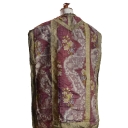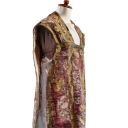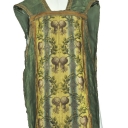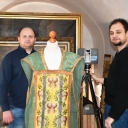In the successive weeks of January 2024, employees of the “Lab 3D” team of the Department of Computer Science of the Lublin University of Technology carried out 3D scanning of historical liturgical vestments belonging to the collection of the Archdiocesan Museum of Religious Art in Lublin and the Museum of the John Paul II Catholic University of Lublin. During the first visit (January 3), scanning stations were built (setting up mannequins and lighting) and a selection of robes to be digitised. In subsequent working visits (January 16, 23 and 30), scanning was carried out of 6 chasubles, 1 dalmatica (a type of tunic worn by deacons) and 2 capes (a priest wears a cape when conducting various types of services, e.g. litanies, rosary, funerals). Thus, we managed to do more than expected at the beginning.
3D scanning was conducted under the supervision of prof. Jerzy Montusiewicz and supervised by the director of the JP II Catholic University of Lublin Museum – prof. Agnieszka Bender and the director of the Archdiocesan Museum – Fr Łukasz Trzciński. The participants of the scanning included prof. Marek Miłosz, dr. Jacek Kęsik, dr. Marcin Barszcz, dr.Marcin Badurowicz and Anna Sałamacha. In total, the entire team from the Department of Computer Science devoted over 65 hours of work to the process of digitising the robes. In addition, we were supported by museum professionals: Anna Szlązak-Nowak (Museum of the JP II Catholic University of Lublin) and Jagoda Maryjewska (Archdiocesan Museum).
3D digitisation of liturgical vestments was performed using several technologies: laser scanning with a terrestrial laser scanner, scanning using structured light technology (white and blue), photogrammetry (SfM) and the LIDAR system built into an Apple tablet. The aim of the proposed approach to the digitisation of vestments was to conduct research on the suitability and effectiveness of individual 3D digitisation technologies for historical liturgical vestments.
The oldest digitised object was a dalmatica dating back to the end of the 15th century, the chasubles came from between the 16th and the 18th century, and the capes dated back to the 19th century. In total, over 110 GB of data was obtained in the form of various types of scans and several thousand photos. Now the team faces a tedious time of data processing, generating digital 3D models of scanned garments, and conducting many comparative analyses of the obtained models. The project participants plan joint scientific publications in journals and conference presentations. In addition, digital 3D models will be made available to researchers (art historians, liturgists) and on the website https://polskiedziedzictwo3d.pl in an open version “for everyone”.
https://cs.pollub.pl/skanowanie-3d-szat-liturgicznych/
https://radio.lublin.pl/2024/01/zabytkowe-szaty-liturgiczne-w-cyfrowej-rzeczywistosci-zdjecia/




